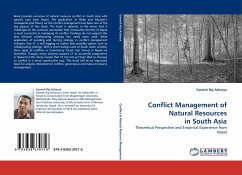
Conflict Management of Natural Resources in South Asia
Theoretical Perspective and Empirical Experience from Nepal
Versandkostenfrei!
Versandfertig in 6-10 Tagen
32,99 €
inkl. MwSt.

PAYBACK Punkte
16 °P sammeln!
Book provides overview of natural resource conflict in South Asia with specific case from Nepal. The application of Blake and Mouton s managerial grid theory on the conflict management has been one of the key aspects of this book. The book is dynamic in the sense that it challenges to the common perception that community forestry of Nepal is most successful in managing its conflict. Findings do not support this idea because collaborating strategy has rarely been used. More application of avoiding and forcing strategy in conflict management indicates that CF is still lagging to realize best pos...
Book provides overview of natural resource conflict in South Asia with specific case from Nepal. The application of Blake and Mouton s managerial grid theory on the conflict management has been one of the key aspects of this book. The book is dynamic in the sense that it challenges to the common perception that community forestry of Nepal is most successful in managing its conflict. Findings do not support this idea because collaborating strategy has rarely been used. More application of avoiding and forcing strategy in conflict management indicates that CF is still lagging to realize best possible option such as collaborating strategy. With a short background of South Asian context, three types of conflicts in Community Forest User Group in Nepal are identified. Though, many scholars support CF as successful programme in Nepal but this study reveals that CF has not yet been able to manage its conflict in a more constructive way. This book will be an important book for anyone interested on conflict, governance and natural resource management.












